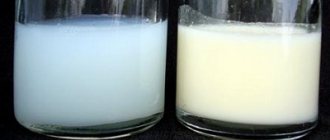vipcosmetolog.ru → Basic summer wardrobe
How beneficial is breast milk for adult children?
In America, scientists have calculated that the state budget can annually save up to $13 billion on pediatrics if women continue to breastfeed their babies for at least six months, because breast milk eliminates more than a dozen childhood health problems, including atopic dermatitis, allergies and middle ear infections.
- Indeed, breast milk contains many vitamins and amino acids, lactobacilli and natural hormones.
- For the immature intestinal microflora of a baby, such food is ideal.
- Mother's milk is hypoallergenic, nutritious and in the first six months completely covers all the needs of the growing body for food and vitamins.
- The unique value of mother's milk for a child is primarily in its composition, which is related to the cellular and tissue composition of the child's body.
In addition, human milk is one of the main links in the biological umbilical cord, as it ensures close contact between the baby and the mother.
If not only babies drink milk
Is it possible for adults and older babies to breast milk? Without a doubt. Despite the fact that it no longer provides the enormous benefits for the body that it did in the first six months of life, there will definitely be no harm from using it. Opponents of long-term breastfeeding claim that children who are fed breast milk for a long time are developmentally delayed, but numerous studies confirm the opposite:
- for example, for people with lactose intolerance to cow's milk, human lactose is ideal;
- and research confirms that this natural drink helps fight gastrointestinal problems, immune deficiency and even cancer.
Do adults drink breast milk? They drink if they are not prejudiced or disgusted. Often a woman cannot overcome lactostasis on her own and her husband comes to the rescue, dissolving the breasts and helping to empty them. In such married couples, the initially trusting relationship becomes even closer.
Human milk in public catering
A special ice cream parlor has opened in London, serving a cold treat made from breast milk. A dozen and a half women supply a fresh and natural product. The cost of a portion of sweet cold reaches $30, but the cafe does not feel a shortage of visitors.
And in China, human breast milk is a special delicacy that only rich people can afford.
Some people find joy in being alone with their children, despite some inconveniences:
The eldest three-and-a-half-year-old daughter is still suckling equally with the younger one and is almost full of milk. Or she is too lazy to eat with a spoon and fork (since they rarely run after her with a plate “take a sip, daughter, swallow another piece”). At night she often began to cry, and for comfort she was sure to drink milk.
I have never found a truly comfortable feeding position to fall asleep without significantly repositioning the babies. That's why I try to feed separately. So the chest is intact, and I enjoy private communication with each cub.
For example, at night it became good to read books for an hour or two with the older one until the younger one fell asleep soundly. Then lie down on the side with the older one. This sometimes makes me feel like all I do all day and night is give milk like a cow. But I understand that this is a very short period of our long life and, generally speaking, it’s not bad at all (to be a beloved cow).
Real experience: got pregnant when the baby was one year old
But forums are forums, but what is tandem feeding in reality? Anastasia, mother of 4 children, doula and lactation consultant
, told Rebenok.BY her story about breastfeeding, her doubts and difficult decisions.
I initially planned to breastfeed my son until he was 2 years old, but I became pregnant. The child was one year old. Of course, I had a lot of doubts in connection with this: how to feed during pregnancy and what to do afterwards. I had to resolve these issues along the way.
Photo source: archive of the heroine Anastasia
Abrupt weaning
If you breastfeed your baby and then suddenly stop this process, this can cause severe psychological discomfort and also harm the health of both mother and baby. Many mothers who abruptly interrupt lactation are forced to take special medications or experience chest pain due to overflowing milk.
Babies, having lost breastfeeding, become more vulnerable to viral infections - their natural immunity weakens. If you go to any “mother’s” forum with a similar question, you can often find dangerous and harmful advice on how to feed a baby and how to wean correctly - for example, separating from the child for several days.
Feeding was painful
The breasts became very sensitive, it was painful to feed throughout the pregnancy, but not all feedings, but at first for a minute or two. The baby began to hang on my chest at night, and in the morning I was completely exhausted. I had practically no sleep, and I understood that I needed strength for the next child. It was psychologically very difficult.
The consultants advised me to wean the child off night feedings. My husband helped - he spent several nights with his son, and, in principle, everything worked out without scandals. Then I slept with him again, as before. Sometimes my son still asked for breasts at night, but I said that I would give them in the morning.
Photo source: heroine archive
I don’t regret feeding
Since he was a year old, my son was teething and slept very poorly. The chest saved me a little: after all, if it weren’t there, I would still have to somehow calm him down, rock him, for example. Then he got sick and ate nothing but breast milk. At these moments I thought that it was very good that I still fed him, and it was easier for him during his illness, and it was easier for me to cope with him.
Towards the end of pregnancy there was little milk and it became like colostrum. I perceived it more as a medicine. My son latched on infrequently, literally 1-2 times a day, the main thing was that I slept peacefully at night.
Are breastfeeding and pregnancy compatible?
Oxytocin and prolactin, the hormones that produce milk and remove it from the body, counteract progesterone and estrogen, the pregnancy hormones. They are opposite to each other. Therefore, gynecologists have concerns that oxytocin will stimulate the uterus to contract during pregnancy when a woman is breastfeeding. A miscarriage or a premature baby may occur. It is important to understand that the uterus becomes sensitive to oxytocin only at the very end of pregnancy at 36-37 weeks.
My doctor from the housing complex said that under no circumstances should you breastfeed during pregnancy, because the unborn baby will not receive enough of what it needs. At the same time, it has been scientifically proven that first of all the fetus receives the necessary substances, then everything goes to milk production, and the rest goes to me. The only one who can get hurt in this situation is me.
I monitored my blood tests, levels of vitamins and minerals, and took courses of vitamins accordingly. Fortunately, my pregnancy went through without any problems at all, it wasn’t in pregnancy, and according to the ultrasound everything was fine. This is the first of four such pregnancies.
Why tandem?
- I decided to feed my son until he was 2 years old.
I felt guilty because he was still very young.
I wanted to soften the appearance of my sister and smooth over the issue of jealousy.
I understood the value of breast milk. I think that this is relevant up to 2 years. And then you can get all these nutrients from food too.
It's very hard to put the kids to bed when I'm home alone. If you need to put one of them to bed, but the other doesn’t want to sleep at that moment, he gets in the way. In this regard, the breast was a great help: I gave it to them at the same time and the one who wanted to sleep fell asleep.
What about milk?
It turns out that when a woman becomes pregnant, hormones switch to pregnancy mode. Due to this, lactation decreases, milk gradually turns into colostrum. The body is fully preparing for the birth of a new baby. After childbirth, colostrum comes first, then milk comes in 2-3 days. The exact same process occurs as if the woman were not breastfeeding.
Photo source: heroine archive
Colostrum has the property that it weakens, because it is necessary to remove meconium from the newborn. Therefore, at the end of pregnancy and several days after birth, the older child may have loose stools, but I have not observed this. In any case, then everything will return to normal.
The instructions say you can feed one baby on one breast and the other on the other. Assign each one their own breast. It is believed that the milk will have different composition. There are receptors on the nipples that, through the saliva of the baby who is attached, produce the composition of milk according to his needs, according to his age, according to his state of health.
Valuable colostrum
In the first days after childbirth, colostrum is released - a yellowish thick liquid. The digestive system of a newborn is still very delicate, and is currently only adapted to feeding on colostrum.
There is no need to supplement the baby with water, glucose solution, and especially milk formula. Colostrum is released, albeit in small quantities, but this is enough for the child.
Colostrum contains more antibodies and white blood cells than breast milk. Thanks to them, the body receives initial immunity to many viruses and bacteria.
Colostrum stimulates the work of an underdeveloped baby intestine, prepares it for the absorption of breast milk, and protects against allergies. It has laxative properties, as a result of which it helps the baby get rid of meconium (the very first stool), and eliminates the risk of neonatal jaundice.
Colostrum is also useful for a woman in labor; it stimulates the activity of the mammary glands in the production of breast milk. Before lactation is established, you should not consume a lot of liquids - this can cause lactostasis (milk stagnation).
The amount of liquid consumed should be limited to 800 ml, including soup and fruit. Frequent breastfeeding best satisfies the baby's nutritional needs and increases milk supply.
A baby up to six months does not need any other food except mother's milk. If there is an urgent need for additional nutrition (the baby is gaining weight inadequately, etc.), it is better to refuse supplemental feeding with a bottle.
Food can be given from a cup, teaspoon or dropper. This way you will prolong at least partial breastfeeding. It is much easier to suck from a bottle and the baby, once accustomed to it, will completely refuse the breast.
After giving birth, the eldest asked for the breast more often
Not everything about our feeding experience went smoothly. There was such a moment: the older child looked at the younger one and while he was getting used to this new person, he completely switched to the chest and stopped eating food from the table. This didn't last long for us, maybe a week, and we went back to 1-2 times a day. My son, of course, asked, tried to whine sometimes, but if I firmly said “no,” that means no.
Photo source: heroine archive
It is very important to take into account your interests as a mother. And it turns out that the mother begins to feed the youngest and eldest around the clock. This, of course, needs to be regulated, and not allow the child to decide these issues.
It was extremely rare for us, as in the pictures, for children to be attached to the breast at the same time, because it was inconvenient. The eldest child is accustomed to breastfeeding in only one position, lying on the bed. Where should I place the youngest? Then I agreed with my son that he would come to us when I put the youngest one to bed, as convenient. But usually I tried to feed them separately.
As soon as my son turned 2 years old, I said that there was no more milk. He took it calmly, without crying, but still remembers the breast every day. I've been refusing for 3 weeks now. Tandem feeding lasted 4 months.
Jealousy
I could come home from the maternity hospital and no longer breastfeed, but I believe that this would be additional stress for the child, because a new family member has appeared, and the mother is here, but does not breastfeed. I would have to sort it all out. I wanted to make everything softer. Of course, if I felt that it was physically impossible for me to feed, that I was exhausted, I would not have done it.
I was very worried about the issue of jealousy: my son is such an owner, perhaps it was tandem feeding that mitigated this. He is not jealous of his daughter. He saw that I was feeding her, and he could also attach himself to the breast when he needed it.
Breastfeeding someone else's baby: immunity and other factors
If the mother, for one reason or another, does not have milk, then the easiest way to switch the baby to formula is the choice of brands allows you to choose the appropriate option. However, many still try to provide their child with a natural product. There are a number of reasons for this:
- Human milk is a kind of disease prevention. Moreover, if the nurse is chosen correctly, then even breastfeeding someone else’s child will increase the baby’s immunity.
- With natural feeding, the milk is in ideal hygienic conditions (no need to worry about steaming the bottle and the freshness of the mixture), and it is also ideal in temperature.
- With enough milk, the baby gets exactly the portion of food he needs.
To feed or not to feed?
In fact, tandem is a rarity; many women stop breastfeeding during pregnancy.
I am for the fact that 2 years is the optimal recommendation for breastfeeding, but in general the decision is always up to the woman herself. The consultant cannot say that this is the only way and nothing else. If a woman wants to feed a child up to 5 years old, then let her feed. If she wanted to wean at 6 months, then that was her decision. We need to support her in this and give recommendations specifically for her situation.
I don’t judge anyone or impose my opinion: it is very important to take into account the mother’s condition, how she generally feels, what kind of child she has, how restless he is. For some people, breastfeeding is exhausting. And someone will lie down while feeding, and seem to have rested. You have to look for a compromise between your comfort and the benefit for the child, but I believe that in no case should you infringe on yourself.
What do you think about tandem feeding?
Pediatricians, WHO specialists and lactation consultants recommend feeding a child with breast milk until two or three years of age, provided that lactation continues and mother and baby feel comfortable. Such nutrition performs useful functions, provides vitamins and elements necessary for the full growth and development of the child. Let's take a closer look at whether breast milk is beneficial after a year. Let's learn how to organize breastfeeding for a child older than one year.
“Bottles fill the stomach,
Breastfeeding is the soul of a child.”
It was once unthinkable for a woman to decide whether to breastfeed her child. If for some reason this was impossible, which was considered a great grief, nurses were found for the child, and cow or goat milk was fed only as a last resort.
With the advent of artificial formulas, they began to convince us that they are an excellent substitute for milk, and are even better in composition and more convenient. Then women began to make a conscious choice in favor of mixtures.
Modern medicine has come to many interesting conclusions about the benefits of breastfeeding for mother and child only now. As a result, the World Health Organization recommends that everyone breastfeed until at least two years of age and resort to formula only in the most extreme cases, and give preference to donor breast milk.
Let's figure out in our article what is better for the child and more convenient for the mother - artificial or breastfeeding (BF)? And why, according to WHO, breastfeeding is the best thing a mother can give to her child.
Here we need to look at three aspects: what is healthier for the baby, what is healthier for the mother and what is more convenient for both of them.
What does breastfeeding do for a baby?
Have you seen the inscriptions on baby food packages that the ideal food for a child is breast milk (HM)? Of course, it has a tremendous impact on the physical and mental health of the baby, and is a key factor for the development of immunity in children under one year old.
GM contains 400 different components that are simply physically impossible to include in an artificial mixture. Its composition is unique for each woman and ideal only for her child.
The content of substances changes even during the day depending on the baby’s needs. Moreover, when feeding twins, the mammary glands produce different milk for each of them.
If necessary, breast milk contains hormones (15 types) and immunoglobulins to form individual immunity - this is unrealistic for an artificial formula.
GM has a perfectly balanced composition of fats (due to polyunsaturated fatty acids, including essential ones), carbohydrates, and amino acids. Mixtures cannot boast of this, which is what subsequently threatens artificial ones with health problems (overweight, diabetes).
In addition, milk is so adapted for the best absorption by a child that it even contains enzymes for its own digestion (for example, lipase for the breakdown of fats and lactase for the absorption of milk sugar lactose).
But hind milk contains lactase, so it is important that the baby sucks the breast until the end, receiving hind milk rich in carbohydrates and lactase.
Even the water in milk is structured in a unique way and has the right to be called real “living water.”
But there is little protein in breast milk. Excess protein, which is found in cow's and goat's milk and formulas, is not only not absorbed by the child, but also puts an unbearable burden on his liver and kidneys, which is harmful to his health. Breast milk contains the ideal amount of protein.
In terms of vitamins and microelements, GM also cannot be compared with mixtures. For example, iron from formula is absorbed by 30%, and from breast milk by 70%.
But it's not just the nutritional value of milk that is crucial when deciding whether to breastfeed your baby. It has been proven that the very process of sucking the mother's breast is important for the development of the child's nervous system and psyche. The intelligence indicators of infants exceed those of artificially raised children.
Breastfeeding promotes the proper development of the facial skeleton, bite, and prevents the development of caries.
Various infections and acute respiratory infections during breastfeeding occur much faster and easier and often do not require any other treatment other than breast milk. Even when a mother gets sick, even before the first symptoms appear, antibodies appear in her milk that protect her baby.
And for a feeling of psychological comfort and safety, closeness with the mother, breastfeeding is necessary. Breast milk has a familiar taste and smell, similar to amniotic fluid, and is very soothing to a newborn. The breast now becomes the channel of nutrition and communication with the mother, as the umbilical cord was during the prenatal period.
If you want the best for your baby, then the question of whether to breastfeed should already disappear by itself.
What does breastfeeding give to a mother?
The myth about the burden of breastfeeding claims that a nursing woman becomes very fat, gets tired quickly, suffers from hair loss, brittle nails and caries and other troubles. In fact, this opinion has no basis in truth.
Breastfeeding gives a woman a lot, both physically and psychologically. Breastfeeding is a natural continuation of motherhood after pregnancy and childbirth, a woman’s body is designed for this, and preparation for breastfeeding lasts all months of pregnancy.
- A newborn is put to the breast right in the delivery room for a reason. When a woman suckles at the breast, she produces the hormone oxytocin, which causes the uterus to contract and prevent postpartum bleeding.
- In addition, oxytocin, together with endorphins, relieves a young mother from postpartum depression. Feeding can bring great pleasure to a woman, which improves her overall psychological state, increases her resistance to stress and increases her vitality.
- Long-term breastfeeding protects a woman from diseases such as breast and genital cancer, cardiovascular diseases, cerebrovascular accidents, osteoporosis, and multiple sclerosis.
- GV improves calcium absorption.
- Breastfeeding, contrary to myths, helps to naturally improve your physical shape through gradual changes in hormonal levels. By the way, according to statistics, breastfeeding does not significantly spoil the shape of the breast.
- Over several months, feeding provides natural amenorrhea and contraception. A prerequisite for this is active breastfeeding, especially night feedings.
- Saving the family budget due to the uselessness of mixtures, bottles, sterilizers and other devices, as well as medications for the treatment of numerous infections.
Convenience for mother and child
What breastfeeding undoubtedly provides is convenience and saving time, effort and money.
Even at the stage of preparation for the birth of a child, you are faced with the fact that you need to decide whether to breastfeed the child or buy a considerable number of items for IV - formula, bottles, nipples, sterilizers, etc. When the baby is born, handling all this stuff will require a lot of nerves, time and money.
Starting from the fact that every time the baby wakes up at night, you need to go to the kitchen and prepare the mixture while he bursts into hungry tears, and ending with inconvenience in public places.
That is, either not go far from home at all, or prepare the mixture in advance and take it with you, but you need to monitor the temperature of the mixture. And if you need to prepare the mixture outside the home, for example, at the airport, you need to find clean water, heat it to the desired temperature, etc.
My mother’s breasts are always with me, the milk is the best and freshest and at the right temperature. With any squeak, you can instantly soothe the baby with your breasts. At night, there is also no need for unnecessary fuss, and if you sleep together, you can breastfeed almost without waking up.
You just have to buy clothes for feeding so that you don’t feel embarrassed about breastfeeding your baby in public, and then you can feel easy and free everywhere, even far from home.
Even when you start introducing complementary foods, GM will help improve digestion through enzymes, and in any case, the baby will never go hungry.
There are many more arguments not mentioned in this article for GW. But the WHO's position in favor of breastfeeding is an indisputable fact that all medical and psychological sciences are finally on the side of nature. While perfectly beautiful advertising of artificial mixtures is only a way to enrich the respective manufacturing companies.
Useful articles:
Books for expectant mothers: list of recommendations
How to breastfeed your baby so that everyone has a good time
How to breastfeed a newborn
Composition and properties of breast milk after a year of feeding
After a year, more immunoglobulins appear in milk, which are aimed at strengthening the immune system and protecting the child from various diseases. It has been proven that infants aged 1.5-2.5 years get sick less often than babies who do not receive breast milk. In addition, such children recover faster and tolerate illness more easily.
Breast milk is a valuable source of protein and fats, vitamins and minerals. After one year, the child receives up to 500 ml of breast milk per day. This volume covers the following needs of the child after one year:
Breastfeeding is especially important for children with allergies or prone to allergic reactions. Such nutrition alleviates allergic conditions and forms a protective film in the intestines that prevents allergens from entering the blood. In addition, prolonged feeding promotes proper bite formation and reduces pain during teething. Thus, we see that the benefits of breast milk after a year remain as invaluable as for children in the first 6-12 months.
How to feed your baby
Doctors say that newborns not only can, but also need to be fed naturally, since artificial formulas do not contain so many useful substances. This means that children may get sick more often. After all, unnatural food is not able to protect babies due to its not entirely natural composition.
Breast milk contains leukocytes and immune proteins, thanks to which the child’s body is reliably protected from diseases dangerous to health. After all, it is known that the immunity of newborns is not developed enough to cope with this or that disease on their own.
Breast milk has the optimal temperature for infants, is sterile, and is easy to consume at any time and anywhere. Therefore, you should not worry about whether you can breastfeed your baby, but feel free to do so.
Natural feeding has many advantages for the health and development of the child, namely:
- daily feeding can provide a powerful emotional connection between baby and mother;
- while sucking, the baby develops a correct bite;
- when teething, mother's milk relieves symptoms and protects the oral cavity from the development of diseases;
- It has been proven that children who eat naturally, as they grow older, get much less sick than “artificially fed” ones, due to their well-developed immunity.
The benefits of breastfeeding after a year for a child
- Supports and enhances immunity, reliably protects against viruses. Infants are less likely to catch colds, tolerate illnesses more easily and recover quickly;
- Improves digestion, improves the absorption and digestion of complementary foods, prevents intestinal colic and stomach upsets;
- Positively affects the development of mental abilities. Infants develop faster and adapt more easily to society;
- Ensures the health of the baby's oral cavity, prevents the formation of malocclusion and reduces the risk of caries, relieves pain during teething;
- Develops the speech apparatus. Infants who receive milk for a long time begin to speak faster and earlier;
- Creates a comfortable psychological environment. The child grows up calmer, psychologically stable and confident. He is not capricious and less susceptible to stress;
- Relieves allergic conditions and protects against allergic reactions;
The benefits of breastfeeding after a year for mothers
- Restores the reproductive system after childbirth;
- Replenishes and accumulates vitamins and beneficial elements that were lost during pregnancy and childbirth;
- Reduces weight as milk production burns a large number of calories;
- Effective prevention of osteoporosis. It has been proven that the risk of developing this disease in old age decreases by 20% with each child fed;
- Reduces the risk of cancer by 55%, including breast and ovarian cancer;
- Restores breast shape and prevents sagging. For more details on how to restore breast shape to a nursing mother, read the article “How to restore breasts after feeding”;
- Provides a close connection between baby and mother.
Disadvantages of breastfeeding after one year
- Emotional and physical fatigue, moral exhaustion;
- Lack of time for sleep and rest;
- It is important to constantly monitor your diet and stick to your diet when breastfeeding, giving up your favorite foods;
- Inability to leave a child without a mother for several days;
- A woman cannot devote more time to herself and other family members;
- A nursing mother cannot fully go to work and be away from her baby for a long time;
- Painful sensations in the mammary glands, the risk of lactostasis and mastitis. It is important to properly care for your breasts and nipples during breastfeeding;
- Painful sensations, cracks and abrasions on the nipples, including if the child bites the breast.
How to replace breast milk
One of the problems of breastfeeding is that the mother has no milk at all or very little. In such cases, according to authoritative experts, the best replacement is adapted industrially produced milk formulas.
Baby formula
These products have been developed and improved over many decades. Currently, work is underway to bring the protein composition of formulas as close as possible to the protein component of breast milk.
It is believed that this can prevent diabetes, obesity and hypertension in adulthood. It is promising to select the composition of formulas separately for night feedings, and separately for daytime feedings, because depending on the time of day, the composition of human milk changes significantly.
The results of these large-scale studies will only be possible decades later, when the babies fed with the new formulas grow up.
You should carefully read all instructions and labels on baby food packages. They may indicate important subtleties and nuances, including the content of vegetable oils (recently, unscrupulous manufacturers may hide low-quality fats, for example, palm, rapeseed, under this unspecified ingredient).
The impeccable purity of the water in which the milk formula for artificial feeding is dissolved is very important. You should carefully and carefully monitor the temperature of the infant formula to avoid burning the baby's mouth, esophagus and stomach or overcooling them.
In the past, in the absence of breast milk, different ingredients were used, but the basis was cow's and goat's milk. Nowadays, many milk formulas are produced, prepared for use.
Therefore, it is inappropriate to experiment with the baby’s health using only folk recipes. For example, a decoction of oats (Hercules flakes) or a Moro mixture.
About cow's milk
Cow's milk in pure and diluted form as an alternative to human breast milk is currently recognized by scientists as not the most successful option due to allergenicity of the body.
Cow's milk proteins, when entering the baby's blood, form complexes that cause hyperreactivity of the immune system, which can be directed against the cells of the host body (autoimmune process).
The same can be said about the rather fashionable goat's milk. However, infant formula is prepared precisely on the basis of cow's milk, which is specially processed, dried and as safe as possible.
Fermented milk products, as they are more adapted primarily to the child’s gastrointestinal tract, are included in standard complementary feeding and supplementary feeding regimens. In dairy kitchens they are prepared under particularly sterile conditions.
Note: breast milk banks and databases of wet nurses are quite widespread. Frozen expressed milk without preservatives can be stored in the freezer for several days.
Myths about long-term feeding
Many are convinced that after a year, breast milk loses its value and fat content, becomes like water, has no beneficial effect, or even causes harm to the baby. However, it is not. The composition of breast milk constantly changes and adapts to the age of the baby and the body's requirements at a certain period. And the fat content of breast milk after a year of breastfeeding, on the contrary, increases two to three times. At the same time, it is easily digestible.
Often, women during lactation experience severe hair loss, deterioration of teeth and skin. However, such problems are not associated with breastfeeding, but with the restructuring of the body and restoration of hormonal levels after childbirth. As practice shows, over time, even with prolonged feeding, a woman’s health and appearance are restored and even improved. Read what to do if your hair falls out a lot while breastfeeding.
Another myth is that when breastfeeding for a long time, children become capricious and become strongly attached to their mother. But this is not true either. Breastfeeding establishes a close and trusting bond between mother and baby, the child grows up confident and calm. On the contrary, if a woman does not breastfeed and pay due attention to the baby, the child will grow up nervous and restless, deprived of affection and care, which negatively affects mental and emotional development.
Diet for a nursing mother
Much of the composition of breast milk depends on the food that predominates in the mother.
During breastfeeding, foods that can cause allergies in the baby should be excluded from the mother’s diet:
- citrus fruits, coffee, chocolate,
- fish and seafood (caviar, crabs and crayfish),
- whole milk, sweets,
- red berries,
- all fruits except green apples and bananas.
Also extremely undesirable for a nursing mother, especially in the first months:
- very fatty and fried foods,
- mushrooms,
- sausages, smoked meats,
- garlic and onion,
- mayonnaise, sauces.
Legumes (beans, peas, soybean components), as well as white cabbage, some nuts, and black bread in the mother’s diet can provoke bloating of the child’s intestines and the inevitable pain impulses, which always cause crying and anxiety.
Allergies in a baby can cause and predispose to them:
- vegetables and fruits yellow, red and orange,
- tomatoes, bananas, kiwi,
- pineapples, grapes.
These are the most important restrictions, but in fact even more can be introduced on an individual basis.
Rules for breastfeeding after one year
- After a year, the number of feedings is three to four times during the day and once or twice at night;
- At two to three years of age, feeding continues once or twice at night and during the day;
- The main feedings occur “around sleep”, i.e. before the baby falls asleep and immediately after waking up;
- Breastfeeding for a child after a year becomes auxiliary, and the main thing is complementary feeding and receiving adult food;
- Introduce new foods into complementary foods, prepare your baby’s favorite dishes more often;
- Gradually reduce the duration of applications;
- Replace unnecessary daily attachments with games and exciting activities, walks, exercises and massage. After a year, a child’s routine should become more varied;
- First, remove unnecessary and unnecessary breastfeeding during the day. Then remove daytime feedings “around sleep”;
- Feedings are removed last at night, before bedtime and upon awakening. As a rule, weaning off night feedings is the hardest thing to do.
What should a mother do?
So, the best solution is to take into account the needs of both mother and child. As the baby grows older, his behavior towards the mother's breast will change. As the baby ages, he will latch on less and less and suck for less time. You will notice such changes yourself.
Also, the baby may ask for the breast due to boredom, excitement or fear; in this case, he can be distracted with something and occupied with a game or something useful. Carefully observe your child's behavior and you will learn to distinguish what exactly causes his desire to attach to the breast. Over time, the baby will simply outgrow the need for breastfeeding and will refuse breast milk; such interruption of feeding occurs naturally and painlessly for both participants in the process.
When is the best time to stop breastfeeding?
Breastfeeding should be fully present in the life of every child until at least six months. After six months, the first complementary foods are introduced, so the number and duration of feedings are gradually reduced. Some pediatricians are inclined to believe that feeding should be stopped after a year. But, as we have already found out, breast milk is also very useful for children aged 1-3 years. Therefore, if lactation is still ongoing, and feeding does not cause discomfort for the mother, breastfeeding can be continued for up to three years.
It is not advisable to stop breastfeeding during teething, epidemics of infectious diseases or when the child is sick, because breast milk strengthens the immune system and helps to recover faster. Don't stop breastfeeding when your baby is stressed. This can be observed upon admission to a nursery, prolonged separation from mother, or when moving.
Weaning will only increase stress and worsen the child's psychological state. It is not recommended to stop feeding in extreme heat, as breast milk satisfies thirst as much as possible and normalizes the water balance in the baby’s body.
How important is it to take into account the difference in the content of proteins, carbohydrates and fats in breast milk of mothers of babies of different ages when choosing a breastfeeding mother?
If we consider breast milk as an integral system of living cells and microorganisms, which cannot be fully modeled using breast milk substitutes of universal composition, it is obvious that regardless of the lactation period of the donor mother, it is advisable, if possible, to use donor breast milk rather than artificial mixture. It is known that even a single use of the mixture leads to a change in the pH of the stomach, and regular artificial feeding leads to the colonization of the intestines with putrefactive bacterial flora.
Is there a problem with digesting the “fattier” milk of a mother whose child is much younger?
It is much easier for the immature digestive system of children to adapt to conditionally fatty, but human milk, which contains enzymes for digestion, than to cattle milk with the addition of vegetable fats.
Will there be enough nutrients in the donor milk of a mother whose child is much older?
The nutrient content (by weight) of breast milk may be the same or even lower than that of formula. But all the components of milk are in an easily digestible form, which is why you need less of them. No matter what age the baby of the donor mother is, all components of milk are optimally suitable for a human baby. Despite the fact that the content of vitamins and microelements differs at different stages of lactation, this does not have a negative effect on the development of the baby. The proof is breastfeeding of children of different ages, the so-called “tandem feeding”.
Polina Lykova, doctor, lactation consultant, member of the SPPM, mother of three children
Research data:
At the 18th International Conference of the Society for the Study of Breast Milk and Lactation, a report was presented by scientists who compared the composition of breast milk of women at different periods of lactation. They collected 132 milk samples from 21 mothers of premature babies, 96 milk samples from 12 mothers of full-term babies 2 to 6 weeks postpartum, and 144 milk samples from 30 mothers who nursed their babies for more than a year, and compared them for individual macronutrient content.
Scientists have concluded that mothers who breastfeed their children for more than a year should not be excluded from the list of donors, even if donor milk is necessary for supplementary feeding of premature infants, since the macronutrient composition of their milk is also suitable for premature infants.
Breastfeeding after a year: is it really necessary?
If you ask grandmothers how long to breastfeed, they will argue that breastfeeding should be stopped after a year, since milk loses all its beneficial properties by this time. And why does a child need milk if he is already big and can eat “adult” food.
If you ask pediatricians and breastfeeding specialists how long to breastfeed, they will answer: if breastfeeding does not cause negative emotions to either mother or baby, then it can be continued.
In fact, there is no clear answer to the question of how long to breastfeed. It is decided individually and depends, first of all, on the psychological readiness of the child. This factor is the main one when weaning him from the breast. Some children are ready for such a step by the age of one year, others only by the age of 2–2.5 years.
How long to breastfeed: is milk still good for you after a year?
Is there any point in breastfeeding a child for a long time, and why should we not rush into weaning?
The common belief that after a year there is nothing useful in human milk is just a misconception. As the child grows up, complementary feeding products take up more and more space in the baby’s menu and become the main source of proteins, fats and carbohydrates. The composition of breast milk also changes to adapt to the baby's growing body. The amount of proteins, fats and carbohydrates in it decreases, but this does not mean that milk ceases to be healthy. It’s just that other functions come to the fore, namely: providing the baby’s body with immunoglobulins and antibodies to protect against diseases, proteins unique in their structure and properties, as well as microelements and vitamins important for the baby (calcium, folic acid, vitamins A, C, B12 ). Mother, continuing to breastfeed after a year, thereby protects him from infections, because milk still contains immune defense factors: immunoglobulins, lysozyme, interferon, etc., which stimulate the development of the child’s own active immunity. Another component of mother's milk - oligosaccharides - promotes the development of beneficial microflora in the baby's intestines, thereby protecting him from dysbacteriosis and allergies.
Due to the unique proteins of human milk, which are growth factors for nerve cells, the harmonious development of the child’s nervous system continues.
Dentists say that breast milk creates a protective film on the baby’s teeth, and protective factors prevent harmful microorganisms from multiplying in the oral cavity, so the teeth of a maturing baby are less susceptible to caries.
So, it turns out that breastfeeding after a year helps to strengthen the child’s health and its harmonious development. Therefore, before deciding to wean, the mother must clearly understand why she is going to do this, and weigh all the positive and negative aspects.
The most important thing to consider when planning to stop breastfeeding is that after a year, breast milk is no longer a source of food for the baby, but mainly a means of emotional and psychological comfort. Sucking at the breast is a means of comfort for the baby, a comfortable, peaceful sleep and communication with the mother. During the process of breastfeeding, mother and baby develop a close, trusting relationship built on deep affection. Untimely (without taking into account the baby’s readiness) and early weaning can be very stressful for the child, and the mother, in response to “freedom from feeding,” will receive many “side effects” on the part of the baby: whims, sudden changes in mood during the day, various fears , urinary incontinence (enuresis), etc.
How long to breastfeed and when can you wean?
There are favorable and unfavorable periods for weaning, which mothers should definitely know about. The most optimal time is considered to be early autumn (September, October) or late spring (April, May). What is the reason for this recommendation? The fact is that during these periods the weather is usually comfortable, and there are no outbreaks of seasonal colds, which means there is less risk that the baby will get sick, having lost “mother’s protection.” It is not the best option to wean your baby in the summer. Indeed, in the warm season, the risk of contracting intestinal infections increases.
At the same time, we must remember that if a mother is going to start taking her child to a kindergarten or development center, then she must wait until the end of breastfeeding until the period of adaptation of the baby to the new place is over, which on average lasts about 1 month.
Another important condition in order to begin to complete lactation is that the child must be absolutely healthy. If the baby was sick, then at least 3 weeks should pass from the moment of recovery.
How to wean?
No sudden changes. The most correct and gentle way to wean is to gradually reduce the number of breastfeedings during the day and night. The main task at the first stage is to eliminate breastfeeding “out of boredom” during the day and accustom him to daytime sleep without sucking (night feedings are canceled as a last resort). This usually takes 1–2 weeks.
To prevent the baby from remembering the breast during the day, the mother should try to captivate him with something: you can come up with new interesting games, read a book, draw, sculpt, etc. You need to be careful not to provoke the child again and not to remind him about feeding. To do this, the mother does not need to sit in the usual places for feeding or undress in front of the baby. If the baby asks for the breast, the mother can try to pretend that she didn’t notice it or didn’t understand and offer the baby his favorite food.
When weaning, the baby has the hardest time parting with feedings associated with sleep. Here you need to act very slowly. First, you need to try to reduce the time you spend at the breast. If your baby usually suckled at the breast for 20 minutes before going to bed, now you need to limit it to 10, carefully take the breast away from him, and clearly explain to the baby that, for example, “the milk has run out.” After 2-3 days, feeding time is reduced to 3-5 minutes, and then completely removed.
At the same time, you can lengthen the ritual of preparing for bed: read a book to your baby longer, tell a new interesting fairy tale, sing songs. You can offer your child to drink milk from a cup.
The mother’s task is to let the baby understand that he can sleep peacefully without the breast. But at the same time, it is very important that the baby feels that the trusting and close relationship between him and his mother will not disappear anywhere if he does not breastfeed.
More attention and tenderness! When breastfeeding ends, the child goes through a stage of psychological separation from the mother, and she must make every effort to help him with this. It is during this period that it is necessary to pay more attention to the emotional state of the baby: hug and caress him.
If the child has learned to fall asleep during the day “without breastfeeding,” it’s time to move on to the next stage and gradually give up latching at night. If during weaning the child has become more capricious, throws tantrums for no reason, sleeps restlessly, and refuses to eat, it means that he is not yet ready to completely separate from his mother, and the end of lactation should be postponed for now.
Most importantly, once you decide to wean, be patient. It is important to listen to the child’s needs and find a pace of weaning that is comfortable for him.
Is your baby ready to wean?
How do you know when your baby is ready to wean? This can be determined by the following signs:
- The baby's primary teeth have erupted and he is eating solid foods well.
- The baby rarely attaches to the breast during the day. All that remains is feeding before bed and after waking up.
- The baby stops using the breast for comfort or attention when he is bored and doesn't know what to do. When a baby asks for the breast during the day, the mother manages to redirect his attention and distract him with some interesting activity.
Is mom ready to wean?
In order for the completion of lactation to proceed painlessly and not cause discomfort to the mother, the so-called involution of lactation must occur, when the mammary gland decreases in size and the amount of milk produced decreases. The breasts adapt to long breaks between feedings (12 hours or more), stop filling with milk, so the woman does not experience any discomfort or desire to express. This usually occurs 1.5–2 years after the start of feeding. Weaning earlier if lactation is not completed correctly can have serious consequences. An abrupt cessation of feeding and hormonal changes in the body often cause pain in the breasts and the development of lactostasis (milk stagnation).
What not to do?
- You cannot wean if your baby is sick. Together with breast milk, the baby receives substances (immunoglobulins, lysozyme, etc.) necessary to fight the disease.
- Wean in summer. In the warm season, the risk of intestinal infections increases, and breast milk protects the baby from diseases.
- Interrupt lactation using special medications. Drugs that suppress milk production are not harmless, and, as a rule, have many side effects, so only a doctor can prescribe them.
- Tighten your chest. Doctors do not recommend doing this, as it can cause blockage of the ducts, the development of edema, stagnation of milk and inflammation of the mammary gland (mastitis).
- Leaving and leaving the child with relatives for a few days. The disappearance of a mother and the cessation of breastfeeding can cause severe stress in the baby. It is much better for the baby if, during the difficult stage of weaning for him, the closest person, who is the mother, will be next to him.
- Apply mustard, brilliant green, garlic, etc. to your nipples. For the baby, these deterrents often cause severe stress. After all, he associates his mother’s breasts with pleasure and enjoyment. In addition, these folk remedies can cause a burn to the oral mucosa in a child, and cause burns or irritation to the delicate skin of the nipple in the mother.








